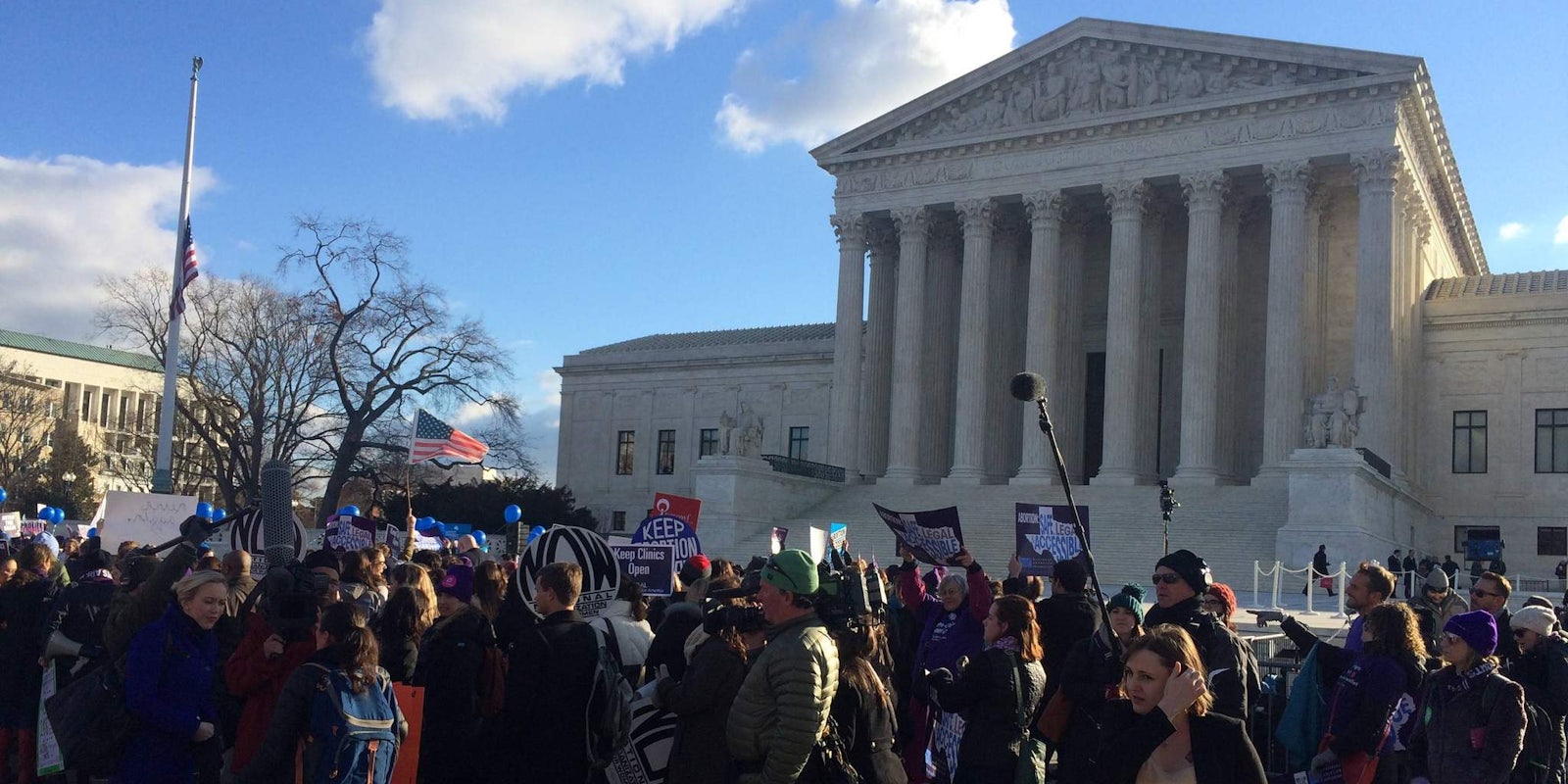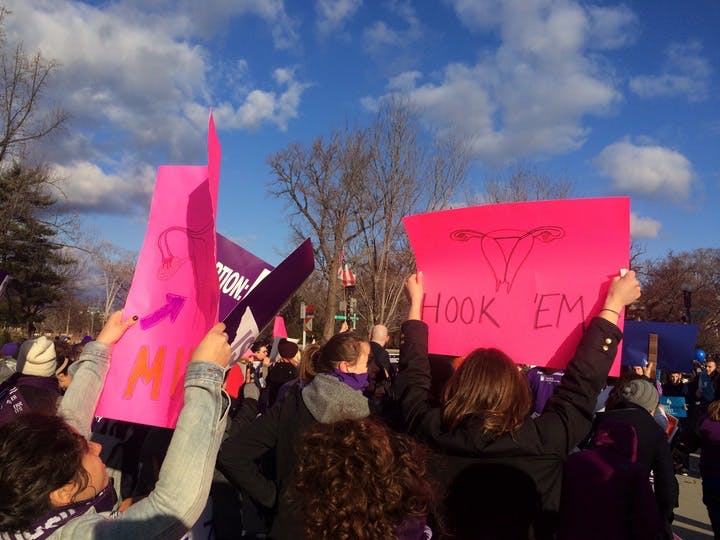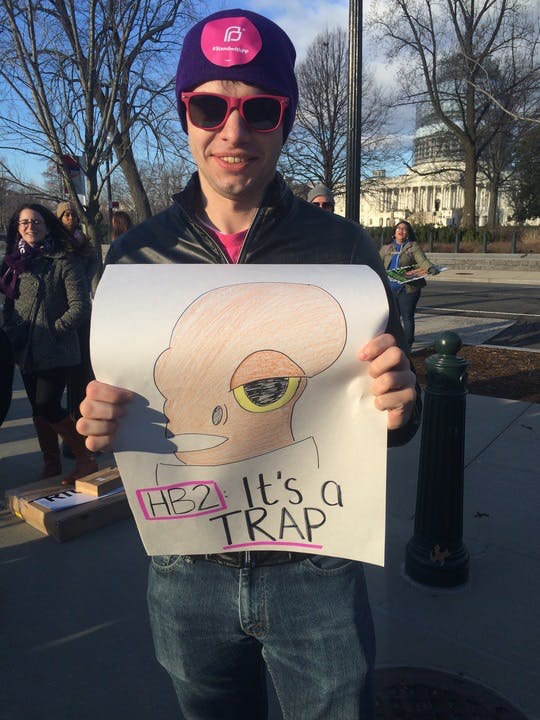On Wednesday, abortion-rights activists packed the Supreme Court wall-to-wall for the first time in 25 years.
Outside the court, massive howls arose from the crowd of supporters and protesters. Many inside and out braved frigid overnight temperatures, sleeping outside the court in hopes of getting inside. The reason for the passion? A case that could affect abortion access nationwide—the kind of political impact on reproductive rights rivaled only by Roe v. Wade.
Every seat in the court was taken, including three cramped rows of over one hundred reporters pressed knee-to-knee in wooden chairs in the press gallery, as oral arguments began in the historic case of Whole Woman’s Health v. Hellerstedt.
Passed in 2013 despite a famous eleven-hour-long filibuster by Senator Wendy Davis, Texas House Bill 2 (HB 2) is a high-profile example of what abortion rights advocates call TRAP laws—short for Targeted Regulation of Abortion Providers. Frequently put in place by conservative lawmakers attempting to reduce access to abortion, TRAP laws focus on hard-to-meet building codes and medical standards, with the Texas law serving as the latest example.
A complete enforcement of the new law would, opponents say, result in all but about eight clinics closing in a state with 5.5 million women of reproductive age.
The plaintiffs in Whole Woman’s Health v. Hellerstedt (formerly Whole Woman’s Health v. Cole) represent a number of local abortion providers who are challenging two main provisions of HB 2: the requirement that all abortion providers have admitting privileges at a nearby hospital, and the stringent building codes that mandate all abortion clinics meet the standards of ambulatory surgical centers (ASC). In Texas, the law has resulted in a severe depletion of services. Prior to the law’s 2013 passage, the state had over 40 abortion clinics. A complete enforcement of the new law would, opponents say, result in all but about eight clinics closing in a state with 5.5 million women of reproductive age.
Because the state’s clinics sued, however, the case slowly crept up through district and circuit courts until it finally landed at the highest court in the nation. Last year, the Supreme Court issued a temporary stay on the ASC portion of the law that allowed some of the clinics to remain open while it considered the case. How the court decides in the next couple of months could transform the way abortion is legislated in states across the U.S. The case is so impactful that not only has the federal government stepped in to advocate for the clinics, it has also attracted 47 amicus briefs in support of abortion providers and 33 amicus briefs in support of Texas.
Stephanie Toti, attorney for the Center for Reproductive Rights, started off the oral arguments by describing the immediate effect of HB 2. Toti’s argument centered on the fact that around half (20) of Texas clinics closed because they were unable to meet the law’s stringent standards. Eight of those clinics closed prior to the admitting privileges requirement taking effect, and another 11 closed on the day the law took effect.
Justices repeatedly asked Toti to prove that the clinic closures were in direct relation to the law, with conservative Justice Samuel Alito questioning whether direct testimony of clinic workers constituted substantial evidence of causation. Liberal Justice Elena Kagan jumped in, calling the closures a “perfectly controlled experiment” because the clinics that closed after the law went into effect reopened as soon as the Supreme Court’s stay was put into place.
U.S. Solicitor General Donald B. Verrilli, Jr. jumped in to argue the federal government’s case on behalf of the clinics. Verilli noted other forms of evidence besides the testimony; for some clinics, the footprint of their buildings would have made ASC-mandated expansions impossible, while others provided financial records showing that they couldn’t afford the necessary renovations.
The court’s liberal jurists were the most outspoken while conservatives on the bench remained relatively quiet, apart from Justice Samuel A. Alito’s occasional request for more evidence and Justice Anthony M. Kennedy’s occasional echoing of Alito. Justice Clarence Thomas was typically silent during the entire hearing.
The four liberal justices repeatedly questioned the validity of the Texas legislature’s claim that increased requirements for abortion clinics would increase the health of the state’s women. Justice Sonia Sotomayor asked whether any other states have been able to show any benefit to having women take abortion medications at an ASC rather than at home, pointing out that medication for cancer treatment and other conditions was typically not taken in front of a doctor.
With conservative and historically anti-abortion Justice Antonin Scalia now gone, the court is weighted toward its four liberal judges, with three conservatives and Kennedy assuming an unpredictable swing vote. Pro-choice advocates are hopeful that Kennedy will swing towards reproductive rights in this case given that he was in the majority that temporarily blocked the ASC requirements last June.
During Texas Solicitor General Scott A. Keller’s argument, the liberal justices ramped up their skeptical round of questioning. Justice Ruth Bader Ginsburg asked whether forcing women, by default, to travel to New Mexico for abortion services due to the decreased access near the state line made sense given that New Mexico does not require clinics to meet ASC standards.
Ginsburg pushed back against Keller again regarding the requirement mandating an abortion doctor have admitting privileges at a hospital within 30 miles of the clinic, but then asked what the benefit was in requiring patients to travel to ACSs.
The four liberal justices repeatedly questioned the validity of the Texas legislature’s claim that increased requirements for abortion clinics would increase the health of the state’s women.
The Texas attorney responded by saying that, because most Texas women live within 50 miles of an abortion provider, they would be likely to use the hospital located nearest the clinic, a response critics says ignores the complaint that 50 miles is still a long distance to travel for a follow-up visit were complications to arise.
Justice Stephen G. Breyer also dominated the Texas backlash. Revealing that Texas abortion clinics already had hospital transfer agreements, Breyer asked whether there was any evidence that women would be benefited by the new admitting privileges mandate when they were already able to access hospital care after abortions. To that, Texas replied simply that there was no evidence. Breyer spoke sharply: “I’ve asked you to give a single example of an instance where there is a benefit … and you say there is none.”
Breyer continued on to note that abortions statistically prove 28 times less risky than colonoscopy procedures, and Kagan offered a statistic showing that liposuction is 30 times more dangerous. One by one, the court’s liberal justices asked for proof that the state of Texas was actually responding to a medical need when it increased the requirements on abortion providers—and Sotomayor concluded that “the legislature is only targeting abortion when there is nothing about the figures … that show a risk so unusual that it needs greater attention.”
The court is expected to announce a decision in the case sometime between now and the end of the session in June.
Read the full transcript of Wednesday’s oral arguments below:
Photo via Mary Emily O’Hara




